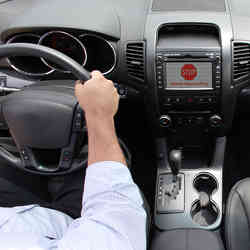
The prospect of the "Internet of cars," of vehicles capable of receiving (and transmitting) a wide variety of data, from entertainment to navigation, from calendars to vehicle system status, has long been discussed, but the balkanization of computing systems in cars has precluded any discernible progress.
That may be changing, with two recent announcements denoting a more standardized focus on vehicular communications.
One of those announcements was delivered at January’s Consumer Electronics Show by a consortium called the Open Automotive Alliance (OAA), an effort by several automakers (Audi, General Motors, Hyundai, and Honda), chipmaker Nvidia, and Google to develop an Android-centered ecosystem for vehicles.
The other announcement was a statement from the U.S. National Highway Traffic Safety Administration (NHTSA) calling for lawmakers to begin the legislative process to mandate a vehicle-to-vehicle (V2V) communications protocol.
Technical details on both are still, for practical purposes, non-existent. In the case of the OAA, a Google spokesman said the company was not elaborating beyond prepared press materials. The NHTSA announcement, similarly, included no firm timetable for V2V communications regulations, standards, or availability.
However, veteran industry observers say the announcements denote a definite shift in the gestalt around automotive Internet. Perhaps most prominent, they say, is the signal the auto industry—historically a home for proprietary and highly specialized technology—is ready to partner with telecommunications developers of both hardware and software technologies, as the communications infrastructure becomes more capable of bringing packets of useful data ever farther afield.
"When you talk to semiconductor vendors and software developers, they are all starting to look at the automotive Internet as the next big thing," says Dominique Bonte, London-based practice director of autonomous driving and location technology at ABI Research. "One billion cars will turn into connected mobile devices, if you will, opening a tremendous amount of opportunity for the entire ecosystem."
Bonte says one sentinel event in the melding of traditional standards-based ICT technology and automotive platforms was the September 2013 announcement by Broadcom that the company was releasing 5G Wi-Fi and Bluetooth Smart Ready technology, wireless automotive chips that allow drivers and passengers to sync and stream content from mobile devices to a car’s infotainment system and rear-seat displays. The new chips also enable high-speed connectivity beyond the vehicle, serving Internet and cloud content via LTE telematics or directly from a hotspot connection. Likewise, Bonte says several automakers, notably Volvo and Renault in Europe, have already adopted Android for their fleets.
"However, Android wasn’t usable off the shelf," he says. "They had to heavily modify it to have fast boot, to have things like multi-audio input/output, and for multi-screen interfaces. …So Android needs to be modified and there are two ways to do it: either every carmaker makes its own version or, and this is where the OAA comes in, you bring the industry together around a common goal of having an automotive grade version. That is exactly what is happening with the OAA."
Another analyst, Liz Kerton, executive director of the Autotech Council, a Silicon Valley-based group that serves as an information conduit for the automotive and technology sectors, equates the OAA to an earlier Google/Android push, the Open Handset Alliance (OHA) launched in 2007. The OHA, Kerton says, was a response to the quest for a more robust mobile operating system than the handset makers themselves were capable of, with no upfront licensing fees charged for the open source system. In addition, she says, automakers have come to realize that their core competencies, such as braking systems, adaptive cruise control, better seating, handling, engines, and so on, did not include telematics, yet the built-in hardware advantages of a car over a phone, such as ample electrical power that all but eliminates battery-life issues, faster location-fixing navigation systems, and more room for a bigger display screen, begged for a software approach that could leverage a global ecosystem of developers.
In the absence of specifics, Kerton and Andreas Mai, global director of smart connected vehicles at Cisco, say the key to capturing market share will be transparency and interoperability in the lower layers of the communications stack and differentiation at the user interface—Apple’s automotive efforts, including its new iOS in the Car effort, include some of the same automakers as the OAA—while simultaneously meeting demands for safety at highway speeds.
"Customers say, ‘I just want my phone on the big (car) screen," Kerton says. "I don’t believe that is what they really want. I think they are really saying they want the customization and ease of use and experience of the phone on the big screen, but I do not think swiping through seven screens of icons to get the app you want on your car screen is necessarily safe."
"I think it is fair to assume the future connected vehicle will be a hybrid of an embedded telematic unit and devices the consumer brings in," Mai says. "The consumer will not relinquish his device, because a lot of our life is embedded in it. Whenever you need connectivity for vehicle-bound services, whether it is remote diagnostics or updates or lock/unlock, the preference will be for an embedded radio, whereas if it comes to all the things we use on our mobile phones, we just want to make sure the car works with it. So in that sense, we are agnostic to the OS.
"We also see room for a federation solution that allows all OS combos between phone and car to operate with each other seamlessly."
Gregory Goth is an Oakville, CT-based writer who specializes in science and technology.



Join the Discussion (0)
Become a Member or Sign In to Post a Comment